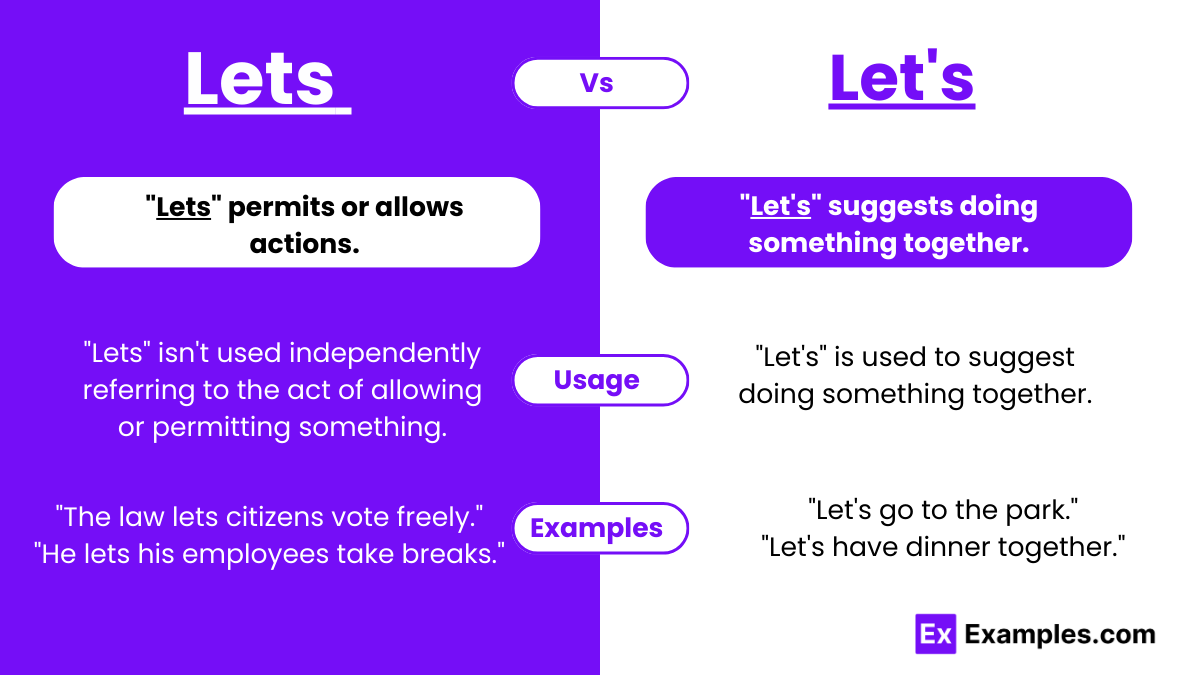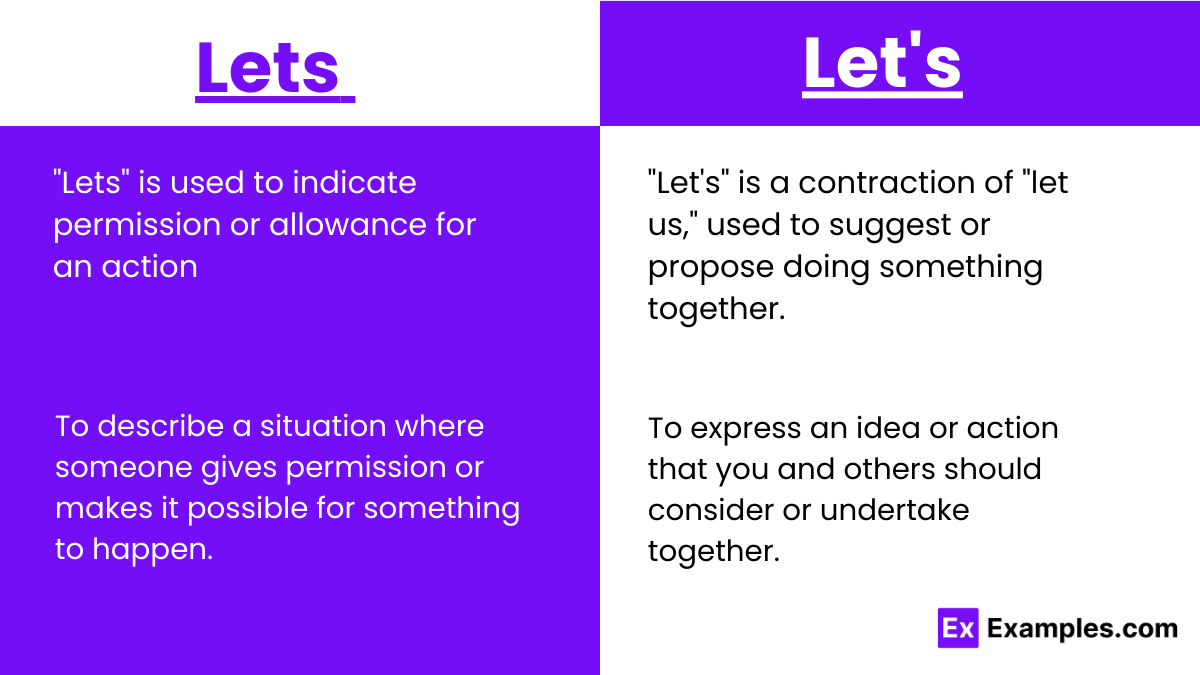Lets vs Let’s – Examples, Differences, Usage, Tips
The English homophones is a challenge that spares no one, not the language novices nor the eloquent natives. Among the myriad pairs that test our linguistic dexterity, “lets” and “let’s” stand out, separated only by an apostrophe yet miles apart in meaning and usage. This article aims to demystify these two, peeling back layers of grammatical nuances to reveal their distinct identities. With a blend of definitions, illustrative examples, and a simple test, we embark on a quest to eliminate any confusion, ensuring you wield these terms with confidence.
The distinction between “lets” and “let’s” is more than just a matter of punctuation; it’s a crossroads of grammar and syntax where many a writer has stumbled. “Let’s” contracts “let us,” beckoning for action or proposal, while “lets” anchors itself firmly in the present tense, granting permission or capability. As we dive deeper into their realms, this article promises to arm you with the knowledge to navigate the homophonic hurdles, making your journey through the English language a little less daunting and a lot more enjoyable.
What Does Lets Mean?
“Lets” functions as the third-person singular present tense form of the verb “let,” which means to allow or permit. When used in a sentence, “lets” typically involves a subject (he, she, it, or a singular noun) granting permission or making it possible for something to happen. For instance, in the sentence “She lets the dog out every morning,” “lets” indicates that she allows the dog to go outside. The use of “lets” is straightforward and is tied directly to actions of permitting or enabling in the present tense.
What Does Let’s Mean?
“Let’s” is a contraction of “let us,” used as a suggestion or proposal to do something together with others. It’s an inviting phrase often employed to express a collective intention or action. For instance, in “Let’s go to the movies,” “let’s” proposes an activity to be undertaken as a group. This contraction combines “let” (to allow or permit) with “us” (referring to the speaker and at least one other person), making it a popular choice for encouraging cooperative action or decision-making.
Summary
“Let’s,” a contraction of “let us,” serves as an invitation or suggestion for a collective action, exemplified by the phrase “Let’s go to the party,” which proposes a group activity. On the other hand, “lets” is used to describe an act of permission or allowance in the third-person singular form, as seen in “She usually lets me go to parties on my own,” indicating that she allows the speaker to attend parties independently. These two forms, while closely related in their base verb, diverge in their application and meaning, highlighting the nuanced flexibility of English verb form.
Difference Between Lets vs Let’s
In the vast landscape of English grammar, small differences can have significant impacts on meaning, as seen in the comparison between “lets” and “let’s.” At first glance, the distinction might seem minimal, marked only by the presence or absence of an apostrophe. However, this slight variation signals two entirely different usages. “Lets” is the third-person singular present form of the verb “let,” indicating permission or allowance, while “let’s” is a contraction of “let us,” used to make suggestions or proposals. Understanding these differences is crucial for clear and precise communication. The following table explores ten key aspects that set “lets” and “let’s” apart, shedding light on their proper application.
| Aspect | Lets | Let’s |
|---|---|---|
| Form | Verb form | Contraction |
| Meaning | Indicates permission or allowance | Suggests a proposal or invitation |
| Usage | Used with third-person singular subjects (he, she, it) | Used for suggesting actions to be taken by the speaker and others |
| Example Sentence | “She lets the cat outside every morning.” | “Let’s go to the beach this weekend.” |
| Grammatical Function | Acts as a verb | Acts as a part of a verb phrase |
| Contraction | No contraction involved | Contraction of “let us” |
| Apostrophe | Does not contain an apostrophe | Contains an apostrophe to indicate the contraction |
| Subject | Typically involves a third party granting permission | Involves the speaker and at least one other person |
| Tense | Present tense | Present tense, but used for making suggestions |
| Formality | Neutral in formality | Also neutral, but more common in informal, conversational contexts |
By navigating the nuances of “lets” and “let’s,” users can enhance their mastery of English, ensuring their language is both accurate and expressive. This clarity in usage empowers speakers and writers to convey their intentions with precision, enriching their communicative abilities.
Examples of Lets vs Let’s
Examples of “Lets”
- He lets his dog walk without a leash in the park.
- The new policy lets employees work from home twice a week.
- She lets the music play loudly when she’s home alone.
- The teacher lets students choose their own project topics.
- This app lets you customize your avatar in various ways.
Examples of “Let’s”
- Let’s grab a coffee after the meeting.
- Let’s think about this problem differently.
- Let’s plan a surprise party for her birthday.
- Let’s take a break and come back to this with fresh eyes.
- Let’s move on to the next topic on the agenda.
When to Use Lets vs Let’s
Deciding between “lets” and “let’s” hinges on the context and the intended meaning of your sentence.
Usage of “Lets”
- You are referring to the act of allowing or permitting something. It is the third-person singular present tense form of the verb “let.”
- The subject of your sentence is a third-person singular noun or pronoun (he, she, it, or a singular noun).
- You want to describe a situation where someone gives permission or makes it possible for something to happen.
Usage of “Let’s”
- You are making a suggestion or proposal that includes yourself and others. It is a contraction of “let us.”
- You want to express an idea or action that you and others should consider or undertake together.
- The tone is more conversational or informal, often used in spoken English or casual writing.
How To Make Sure You’re Using The Right Word
Ensuring you’re using “lets” and “let’s” correctly involves understanding their distinct meanings and functions in a sentence. Here are strategies to help you choose the right word:
- Identify the Subject: “Lets” is used with a third-person singular subject (he, she, it, or a singular noun). If your sentence involves someone allowing or permitting an action, use “lets.” Example: “She lets the cat outside.”
- Check for a Proposal or Suggestion: If you’re suggesting an action that includes yourself and others, you’re likely looking for “let’s,” which is a contraction of “let us.” Example: “Let’s go for a walk.”
- Look for the Apostrophe: The presence of an apostrophe in “let’s” indicates a contraction. If your sentence combines “let” and “us,” you should use the apostrophe. Example: “Let’s (let us) try that new restaurant.”
- Test by Expansion: Expand “let’s” to “let us” in your sentence. If it makes sense and maintains the intended meaning, then “let’s” is correct. Example: “Let’s (let us) start the project” becomes “Let us start the project.”
- Consider the Action: “Lets” often refers to enabling or allowing something to happen, while “let’s” is used for proposing actions or activities. If you’re granting permission, use “lets.” If you’re suggesting doing something together, use “let’s.”
- Substitute to Test: Try substituting “allows” for “lets” and see if the sentence still works. If it does, “lets” is likely the correct choice. Example: “The rule lets (allows) us play outside.”
Tips for Lets and Let’s
Mastering the use of “lets” and “let’s” is key to clear and effective communication. Here are some tips to help distinguish between the two and use them correctly:
- Understand the Difference: Remember that “lets” is the third-person singular present tense of the verb “let,” meaning to allow or permit. “Let’s” is a contraction for “let us,” used to make suggestions or proposals.
- Check the Subject: If the subject of your sentence is he, she, it, or a singular noun, and the action involves allowing or permitting, use “lets.” Example: “She lets her cat outside every morning.”
- Look for the Apostrophe: The apostrophe in “let’s” signals a contraction of “let us.” If your sentence is suggesting an action for a group that includes the speaker, “let’s” is the correct choice. Example: “Let’s go to the movie tonight.”
- Expand to Check: If you’re unsure, expand “let’s” to “let us” in the sentence. If it still makes sense, then “let’s” is correct. Example: “Let’s (let us) decide on the project’s theme.”
- Substitution Test: Try substituting “allows” or “permits” for “lets.” If the sentence retains its meaning, then “lets” is correct. Example: “This policy lets (allows) employees to work remotely.”
- Context Clues: Use the context of your sentence to guide you. Proposals or suggestions involving a group action typically require “let’s.” Situations where someone is being given permission or an opportunity usually need “lets.”
- Practice Makes Perfect: Regularly practice writing sentences with both “lets” and “let’s” to build your confidence and intuition in using each word correctly.
- Proofread and Review: Always proofread your writing to catch any misuse of “lets” and “let’s.” A fresh look can help you spot and correct mistakes.
FAQs
Is There a Difference Between Lets and Let’s?
Yes, there’s a key difference: “lets” refers to allowing or permitting (third-person singular), while “let’s” is a contraction for “let us,” used for suggestions or proposals.
Why is Everyone Saying Lets Go?
“People often say “let’s go” as a motivational phrase or to express enthusiasm about starting something or moving from one place to another. It’s a call to action.”
Is Lets an Informal Word?
“Lets,” as the third-person singular form of “let,” is neutral in tone and not specifically informal. It’s suitable for both formal and informal contexts depending on usage.
When to Say Lets Go?
“Say “let’s go” when you’re encouraging action or readiness, either to physically move or to start an activity. It’s a rallying call often used in team settings or among friends.”





